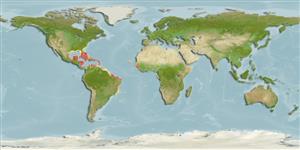分類 / Names
共通名の | 類義語 | Catalog of Fishes(部類, 種) | ITIS | CoL | WoRMS | Cloffa
Environment: milieu / climate zone / depth range / distribution range
生態学
海 関連する礁; 深さの範囲 0 - 40 m (Ref. 13121), usually 0 - 3 m (Ref. 9710). Subtropical; 32°N - 26°S, 100°W - 32°W
Southwestern Atlantic: from Bahamas and Florida southwards to Brazil.
サイズ / 重さ / 年齢
Maturity: Lm ? range ? - ? cm
Max length : 7.5 cm TL オス/雌雄の選別がない; (Ref. 13628)
簡単な記述
検索表 | 形態学 | 形態計測学
背面の脊椎 (合計) : 20 - 21; 背鰭 (合計) : 11 - 12; 肛門の骨: 2; 臀鰭: 20 - 22. With 3-5 dark brownish-red bands in form of inverted triangles along side. No other labrisomid has this distinctive color pattern (Ref. 26938). Head with a few small dark spots; bars on body sometimes not very dark but outlined by dark bars; scattered dots then often present elsewhere on the body (Ref. 13442).
Inhabits coral reefs and rocky shores. Often found in crevices, or among weed and rubble (Ref. 13121). Feeds on crustaceans (Ref. 13628).
Life cycle and mating behavior
成熟 | 繁殖 | 放精 | 卵 | 生産力 | 幼生
Robins, C.R. and G.C. Ray, 1986. A field guide to Atlantic coast fishes of North America. Houghton Mifflin Company, Boston, U.S.A. 354 p. (Ref. 7251)
IUCNのレッドリストの状況は (Ref. 130435: Version 2024-1)
Human uses
水産業: 商業; 水族館・水槽: 商業
用具
特記事項
XMLをダウンロードして下さい
インターネットの情報源
Estimates based on models
Preferred temperature (Ref.
123201): 26.3 - 28.2, mean 27.5 °C (based on 645 cells).
Phylogenetic diversity index (Ref.
82804): PD
50 = 0.5000 [Uniqueness, from 0.5 = low to 2.0 = high].
Bayesian length-weight: a=0.00933 (0.00410 - 0.02122), b=3.10 (2.91 - 3.29), in cm total length, based on LWR estimates for this (Sub)family-body shape (Ref.
93245).
栄養段階 (Ref.
69278): 3.5 ±0.50 se; based on food items.
Fishing Vulnerability (Ref.
59153): Low vulnerability (10 of 100).
Nutrients (Ref.
124155): Calcium = 75.4 [33.0, 164.9] mg/100g; Iron = 0.804 [0.436, 1.431] mg/100g; Protein = 19.4 [18.3, 20.5] %; Omega3 = 0.263 [0.143, 0.481] g/100g; Selenium = 10.5 [4.3, 22.4] μg/100g; VitaminA = 124 [37, 429] μg/100g; Zinc = 1.45 [0.88, 2.25] mg/100g (wet weight);
